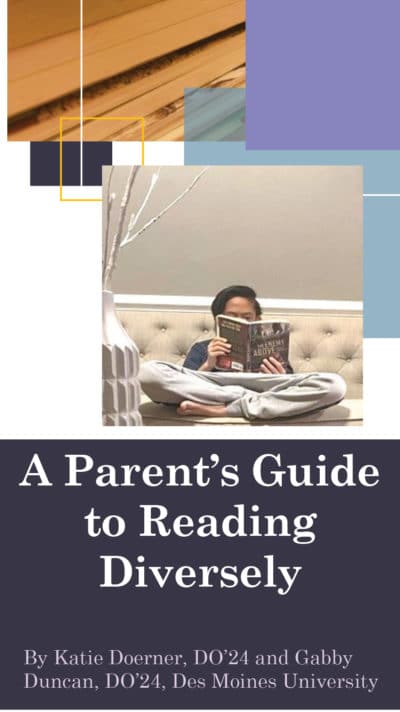
Katie Doerner, a second-year student in DMU’s osteopathic medicine program, has known she wanted to work with kids since, as she jokes, she realized a career as a professional basketball player wasn’t in the cards. She is the Midwest district representative for the Section on Pediatric Trainees (SOPT) of the American Academy of Pediatrics (AAP), which strives to enable aspiring pediatricians to be strong advocates for the health and well-being of all children.
Every year, SOPT organizes an advocacy campaign around a topic relevant to children’s health; to support this year’s topic, “Rx Against Racism,” Katie and classmate Gabby Duncan, the leader of the DMU Medical Humanities Society’s book club, developed “A Parent’s Guide to Reading Diversely,” a brochure that provides resources and recommendations to help parents find ways to “integrate diverse books and learning into their children’s lives.”
“When it comes to raising a generation to fight racism, what better way is there than through literature?” the brochure queries. “At ages as young as two years, children are able to observe and internalize racial biases. Positive exposure to many cultures helps children to formulate more progressive views and brings visibility to cultures other than their own.”

To develop the guide, Katie reached out to her cousin, Holly Doerner, a reading specialist for K-8 students in Michigan. Holly expressed concerns about how few books feature children of color, especially at appropriate reading levels for her elementary-age students.
“That was in the back of my mind while I was working on this,” Katie says.
Amy Shriver, M.D., a pediatrician and assistant professor of specialty medicine at DMU, says children and families often use books and shared reading to promote relational health and well-being.
“Books can be used, especially in early childhood, as ‘windows’ into life experiences of others, or as ‘mirrors’ that reflect experiences of the reader,” she says. “Books with representation of different genders, ethnicities and cultures expand our understanding of diversity and promote a kinder, more caring society.”
As an undergraduate working part-time at the University of Minnesota Children’s Hospital, Katie learned about Reach Out and Read, a nonprofit organization that works to incorporate books into pediatric care and encourage families to read aloud together to give young children a foundation for success. It’s among the online resources she included in her parent’s guide, along with the following:
- The National Education Association and its Read Across America program, which strives to instill a lifelong love of reading
- Storyline Online, which features celebrities reading their favorite children’s books (James Earl Jones, Al Gore and Oprah Winfrey are just a few of the readers)
- We Need Diverse Books, a “resource for resources” on books and reading
- A Novel Mind, a database that’s an “absolute gold mine for any parent wanting to help their child understand neurodiversity” and mental health; users can filter resources by reading level, topic and other parameters
- PBS, which offers options and advice for having conversations about race
The guide also lists “favorite picks” of books for toddlers, preschoolers, students in elementary and middle school and young adults. It suggests questions parents can ask their kids while reading, such as “How did what happened in the story make you feel?” and “Did the characters in the story remind you of yourself or someone you know?”
Marianka Pille, M.D., FAAP, associate professor of specialty medicine, hopes to distribute Katie’s guide in her practice. She says she has patients and parents who “crave resources” that promote diversity, equity and inclusion (DEI) and that depict youth from diverse groups.
“Combining that with literacy promotion is a double win. Promoting literacy is just one of many important things that happen in pediatrics, and it is always nice to have specific recommendations for patients,” she says. “Opening the topic of DEI with all patients is an important goal, and pairing it with literacy is a nice way to start the conversation. Advocacy work is at the heart of pediatrics, and it is thrilling to have medical trainees who are also dedicated to it.”
As one of those “medical trainees,” Katie hopes the AAP, the DMU Family Medicine Clinic, Blank Children’s Hospital in Des Moines and possibly other health care organizations also will distribute her parent’s guide.
“It’s more important to me that the guide is used than for me to get credit for it,” she says. Helping families navigate race-related barriers and discussions reflects a philosophy of osteopathic medicine, she adds: “In D.O. schools, we talk about helping every aspect of a patient’s life, not just their symptoms or physical health.”

